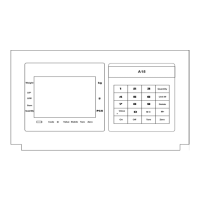
Do you have a question about the Yaohua Weighing System XK3190-A15 and is the answer not in the manual?
| Model | XK3190-A15 |
|---|---|
| Category | Accessories |
| Display Type | LED |
| Storage Temperature | -25°C to +55°C |
| Accuracy Class | III |
| Max. divisions | 3000 |
| Conversion rate | 10 times/second |
| Load cell excitation | DC 5V |
| Display | 6-digit LED |
| Interface | RS232 |
| Power Supply | AC 220V, 50Hz |
| Operating Temperature | -10°C to +40°C |
| Humidity | < 85% RH, Non-condensing |
| Input signal range | -16mV to +18mV |
| Max. connection number of load cell | 4 at 350 ohm |
| Weighing Range | Depends on the connected load cells |
Details model, accuracy, power supply, fuse, pre-heat time, operating and storage conditions, dimension, and weight.
Covers conversion principle, input signal range, sample rate, and stimulating voltage for the weighing indicator.
Describes the LCD type, character height, bit allocation for data display, and status indicators.
Details optional RS232 interface for controlling units, PC, or scoreboard connection.
Provides visual layout of the indicator's front panel controls and back panel connections, including load cell and power inputs.
Explains the operation of individual keys like Zero, Tare, M+, MC, Delete, .Value, Quantity, Unit W, On, Off, and numeric keys.
Details the operation of key combinations, such as entering calibration mode.
Details the 9-pin socket usage and provides a graph illustrating load cell to indicator connection.
Emphasizes reliable connection, power-off operation, socket security, and static electricity prevention.
Defines the RS232 interface and alarm signal output, including pin definitions like TXD, GND, CTRO_O.
Explains continuous sensing, data format, and provides examples for weight value transmission.
Presents a graph for the fixed value alarm output, showing connections to alarming systems or control units.
Guides through connecting the load cell, powering on, self-checking, and entering the calibration password.
Details settings for division, zero parameter, and digital filter intensity.
Explains inputting full range, zero-point calibration, and linearity calibration with specific loads.
Provides notes on anti-vibration select, stable range, filter intensity, and how to exit calibration.
Covers powering on the indicator, self-checking, and initial status after charging the battery.
Explains how to manually set the indicator to zero and perform tare operations.
Details the process for setting working method, background light, fixed value alarm, and baud rate.
Describes how to enter unit price, calculate sum, and handle negative weights in price computing mode.
Explains two methods for counting: unknown unit weight and known unit weight.
Details how to accumulate weight/quantity and clear the accumulated values using M+ and MC keys.
Explains setting low/high limit alarms for fixed value counting.
Guides on performing pre-taring operations within the counting status.
Describes how to view the indicator's inner code and its relation to the outer division rate.
Provides a table detailing error codes (e.g., Err 01, Err 02, Err 03, Err 10) and their corresponding solutions.
Explains automatic charging when AC 220V is on, wire polarity, and initial charge duration.